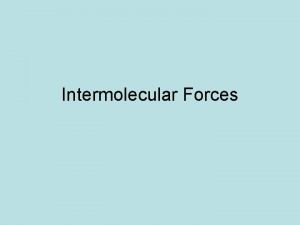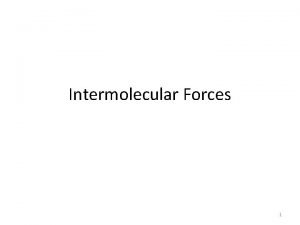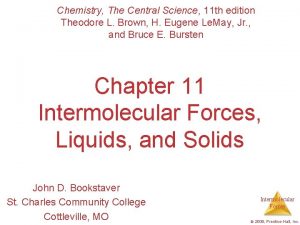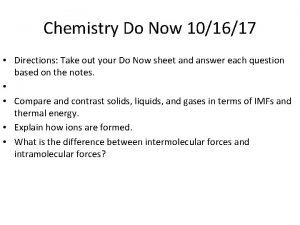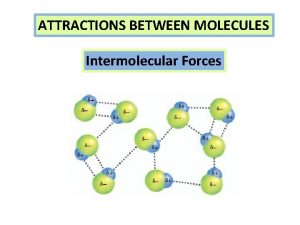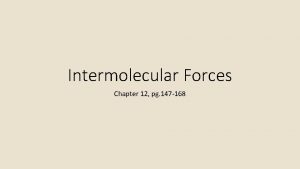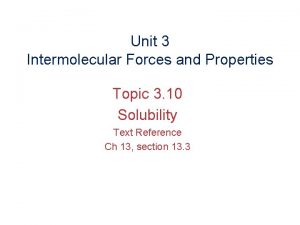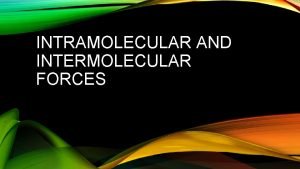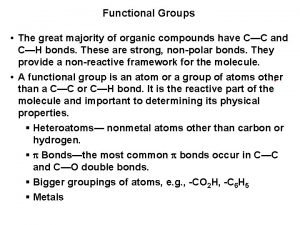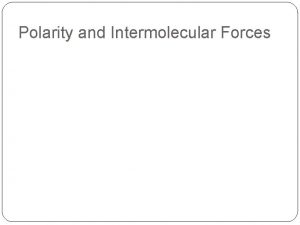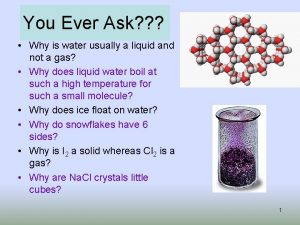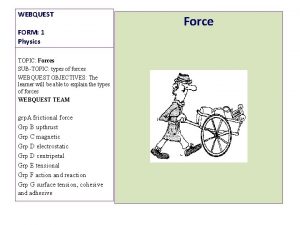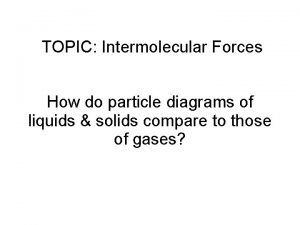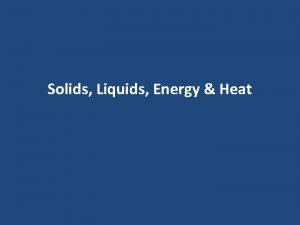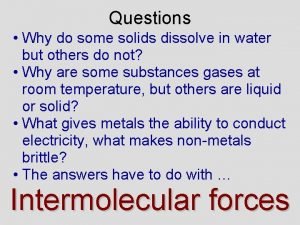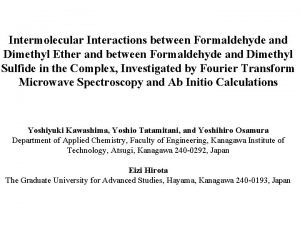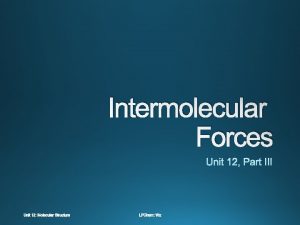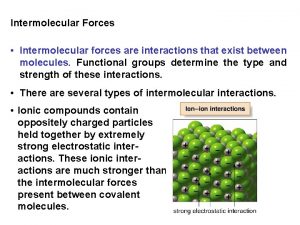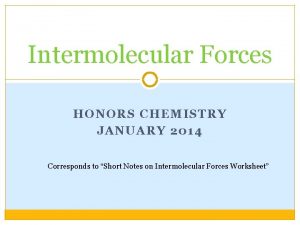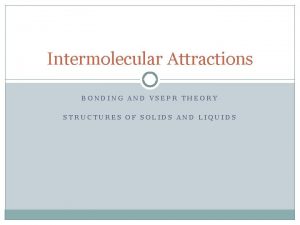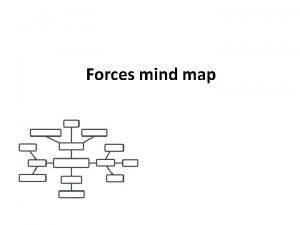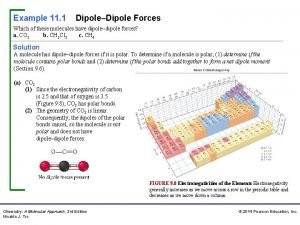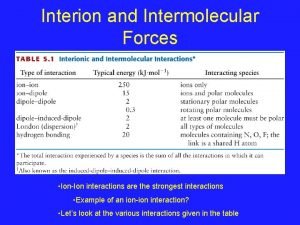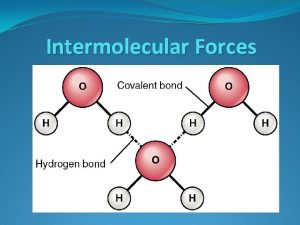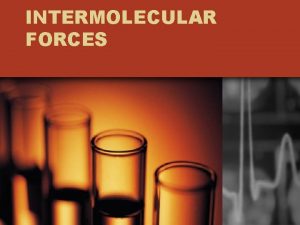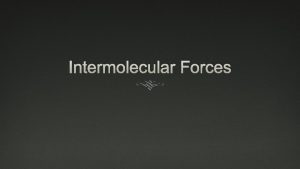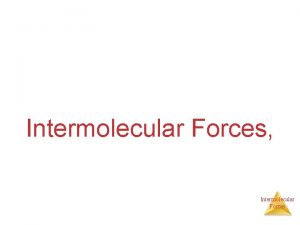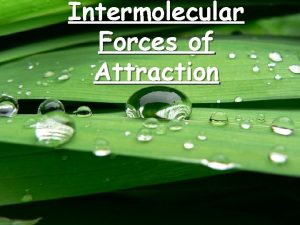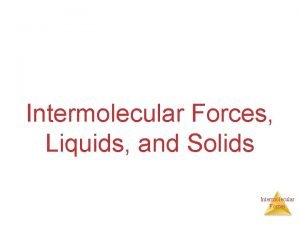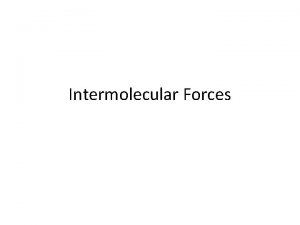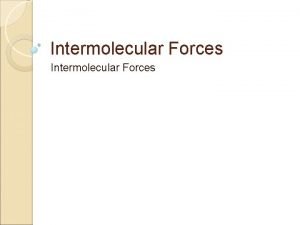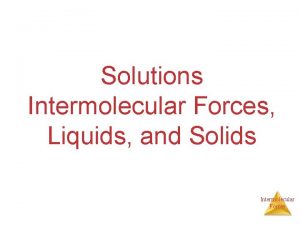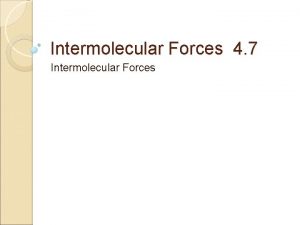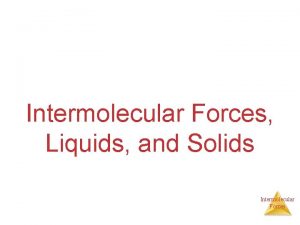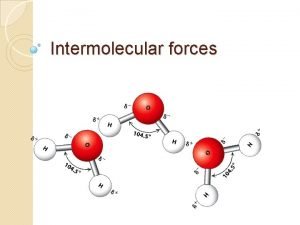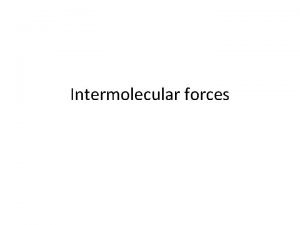Interion and Intermolecular Forces IonIon interactions are the


































- Slides: 34

Interion and Intermolecular Forces • Ion-Ion interactions are the strongest interactions • Example of an ion-ion interaction? • Let’s look at the various interactions given in the table

Ion-Dipole Interactions • Best example: Hydrated Ions • The polar character of the water molecule allows it to interact with cations or anions z = ion charge • We can describe the interaction energy: µ = Electric dipole moment r = distance

Dipole-Dipole interactions • Let’s look at the interactions between polar molecules The Dipole-Dipole interactions force some order in the solution

Dipole-Dipole interactions Dipole-Dipole interaction energy: µ 1: Dipole moment of molecule 1 µ 2: Dipole moment of Molecule 2 The fact that the distance is cubed means that the energy falls of much more rapidly than ionion interactions as the interacting species are separated

Which molecule has the higher boiling point: p-dichlorobenzene and o-dichlorobenzene Dipole moment for the molecules?

Which molecule has the higher boiling point: cis-dichloroethene or trans-dichloroethene?

Hydrogen Bonding • A special type of dipole-dipole interaction • Hydrogen bonding only occurs between: N-H O-H and Lone pair e- on N, O, F F-H

Hydrogen Bonding • Hydrogen bonds are one of the most important interactions in biological systems Hydrogen Bonds: • Hold proteins together • Allow DNA base pairs to match up • Allow structural polymers to interact Hydrogen bonds are the strongest type of non-ionic intermolecular force

Dipole - Induced Dipole • The presence of a molecule with a strong dipole moment can induce or create a dipole in a non-polar molecule – This depends on the strength of the dipole and the polarizability of the nonpolar molecule 1: Dipole moment of molecule 1 2: Polarizability of molecule 2

London Forces • London Forces are attractive forces between non-polar molecules (all molecules have them, but they are much weaker than other types) • These are 1 of the two weakest intermolecular forces • How do these interactions arise?

London Forces • The electron clouds are constantly shifting and sometimes the molecule gets a small dipole moment – Neighboring nonpolar molecules will have their electron clouds distorted and will form a dipole of opposite orientation • Then the process starts over (Dipole disappears and reforms) (1 x 10 -16 sec to form and disappear)

London Forces 1: Polarizability of molecule 1 2: Polarizability of molecule 2 r 6 !!!! Very short range effects!! • What determines Polarizability? • Large atomic radii • Low Zeff • High Polarizability = Large London Interactions

Let’s look at London Forces and Polarizability with respect to physical properties As we go down a group, the atomic radius increases and the melting and Boiling points increase (takes More energy)

London Forces and Molecular Shape • Because the London Force energy drops off VERY sharply as a function of distance, molecular shape is a major contributor to London Force energy Which has the higher boiling point?

Thinking about Biology Chemically • All living organisms use energy • Energy comes from chemical reactions • The energy stored in chemical bonds is harnessed by proteins to catalyze other reactions

Functional Groups of Biologically Active Molecules • All the chemistry of life is performed using these chemical entities • We’ll go over these in MUCH greater detail in the next lecture

ATP: The Energy Currency of the Cell

Formation of Biomolecules • How did the vast array of biologically active molecules come to be? • Initially, it is thought that only NH 3, H 2 S, CO 2, CH 4, N 2, H 2 and H 2 O were present on the early Earth • However, the planet was volcanically active (heat and pressure) and there was significant electrical activity in the atmosphere

The Miller-Urey Experiment • Formaldehyde and hydrogen cyanide are usually formed, BUT, after prolonged reaction, so are AMINO ACIDS • The experiment can be taken a step further and be performed with simple amino acids as starting material. • Protein like molecules are formed

Biological Polymers and Directionality Biological Polymers have a specific direction to them based upon their sequence • Proteins: Amino terminus to Carboxy terminus • Nucleic Acids: From 5’ to 3’ • Carbohydrates: From nonreducing terminus to reducing terminus

Types of Cells • The different biologically active molecules and polymers arrange themselvs to form cells • The formation of a lipid bilayer is instrumental in this! • We can distinguish between types of cells based upon the presence of organelles, especially the nucleus • Prokaryotic do not have a nucleus or other organelles but Eukaryotic cells do • Organelles are specialized compartments that allow unique reactions to occur within them

Types of Cells

Types of Cells

Section 1. 9: Biochemical Energetics • All cells need energy to catalyze the reactions of life • ATP (Adenosine triphosphate) is the energy currency of the cell • The gamma phosphate is hydrolyzed off • This is an example of a high-energy bond

Thermodynamics Let’s review some topics we covered in CHEM 105: • Spontaneous Reaction: A reaction that occurs without outside intervention • May be very fast or slow • Free Energy: G, is a measure of the capacity of a system to do thermodynamic work • Only G can be measured • Enthalpy: H, is a measure of the heat stored in a chemical bond • Entropy: S, is a measure of the disorder of a system G = H - T S

Think About It… If all systems in the universe tend towards disorder, how can cells exist in the first place?

Biochemical Thermodynamics 1. The Free Energy of a system decreases in a spontaneous reaction G < 0 This is also called an Exergonic reaction 2. A system at equilibrium has no Free Energy Change at All G=0 3. In a nonspontaneous reaction, energy must be input into the system G>0 This is also called an Endergonic reaction

Acids, bases and p. H • We talked about strong acids and bases last lecture in our discussion of Electrolytes • A strong acid completely dissociates in solution HA --> H+ + Ap. H = -log [H+] or p. H = -log [H 3 O+] For a strong acid, the p. H will equal the -log[H+] Remember: Some acids are polyprotic (H 2 SO 4, H 3 PO 4)

Acids, Bases and p. H • For strong bases, we need to remember that ph and p. OH are related: p. H + p. OH = 14 • Take the negative log of the [OH-] and subtract it from 14 to determine the p. H

Acids, Bases and p. H • Weak acids (and bases) pose a new problem: The fact that they do not completely dissociate in solution – They exist in an equilibrium between the acid and conjugate base HA (aq) + H 2 O (l) --> H 3 O+ (aq) + A- (aq)

Common Biochemical Acids

Henderson-Hasselbach Equation Enzymes have very specific p. H ranges in which they will function

Henderson-Hasselbach Equation

Titration Curves • When we mix an acid and a base together in small increments and then measure the p. H, we can make a Titration Curve HA (aq) + OH- (aq) H 2 O (l) + A- (aq) The equivalence or endpoint (EP) is the point in the titration at which all of the acid molecules have reacted with base Halfway to the EP: [HA]=[A-] • The p. H at this point is the p. Ka. Why? At the EP: [A-] = Initial [HA]
 Antigentest åre
Antigentest åre Intermolecular and intramolecular forces
Intermolecular and intramolecular forces Intermolecular forces in a lava lamp
Intermolecular forces in a lava lamp Inter vs intramolecular forces
Inter vs intramolecular forces The attractive force between water molecules
The attractive force between water molecules Gecko feet facts
Gecko feet facts Intermolecular forces
Intermolecular forces Viscosity and intermolecular forces
Viscosity and intermolecular forces Intermolecular forces capillary action
Intermolecular forces capillary action Molecular attraction
Molecular attraction Pg 147
Pg 147 Unit 3 intermolecular forces and properties
Unit 3 intermolecular forces and properties What is induced dipole
What is induced dipole Electronegativity and intermolecular forces
Electronegativity and intermolecular forces Boiling point vs melting point
Boiling point vs melting point Polarity and intermolecular forces
Polarity and intermolecular forces London dispersion forces induced dipole
London dispersion forces induced dipole Intermolecular forces webquest
Intermolecular forces webquest Intermolecular forces
Intermolecular forces 3 types of intermolecular forces
3 types of intermolecular forces Concept of imfa
Concept of imfa Factors that affect solvation
Factors that affect solvation Dipole dipole interaction example
Dipole dipole interaction example Pvc intermolecular forces
Pvc intermolecular forces Dimethyl ether intermolecular forces
Dimethyl ether intermolecular forces Intermolecular forces symbol
Intermolecular forces symbol Dipole-dipole interaction example
Dipole-dipole interaction example Strength of intermolecular forces
Strength of intermolecular forces Van der waals attraction
Van der waals attraction Strongest to weakest intermolecular forces
Strongest to weakest intermolecular forces Intermolecular forces from strongest to weakest
Intermolecular forces from strongest to weakest Type of intermolecular forces
Type of intermolecular forces Hydrogen bonding as intermolecular forces
Hydrogen bonding as intermolecular forces Friction mind map
Friction mind map Ch2cl intermolecular forces
Ch2cl intermolecular forces





